Gaditano Pouter Pigeon: Characteristics And Behavior
Gaditano Pouter pigeon is a breed of fancy pigeon. Fancy pigeons are the domesticated version of pigeons with unique traits and features. This breed came from wild rock doves after years of selective breeding process.
They fall under the category of “Pouter and Cropper” pigeons. Since their origin in Spain, the Gaditanos have been one of the most popular breeds among fanciers, mainly due to their exceptional inflatable crop around the neck, which they wear like a jewel.
The peculiarity of their appearance has swayed people to keep them as show birds for a long time. This breed is also known to have been used in a popular sport called “thieving.”
In this article, we will explore in depth the many varieties of Gladitano Pouters, their appearance, feeding habits, breeding and habitats, temperament, and raising tips.
Gaditano Pouter Pigeon Profile
| Name | Information’s |
|---|---|
| Scientific Name | Columba livia domestica |
| Common Names | Pouters; Croppers |
| Origin | Spain |
| Size | 1 ft to 1.4 ft |
| Weight | 300-850 grams |
| Lifespan | 01. Domestic: 10-20 years 02. Wild: 3-5 years |
| Physical Features | Large and round body; striped on wings and black, white, brown, etc. colored feathers |
| Temperament | Energetic, gentle, and lively |
| Behaviors | Loyal and follow around owners; very social; mate for life; protective of their flocks; investigative; a show-off |
| Special Features | Have an enlarged balloon-like esophageal area |
| Breeding & Maintenance | Better to breed them in a cage; Clean loft with lime water before breeding; give calcium-based food |
| Common or Popular Varieties | No other varieties of Gaditano Pouter pigeons as this a breed |
Interested in similar topics on pigeon breed:
Overview of Gaditano Pouter Pigeon
The Gaditano Pouters are a fancy pigeon breed characterized by a bag around the neck, known as the crop. Because of this feature, these particular pigeons are categorized into a subgroup called the croppers and pouters.
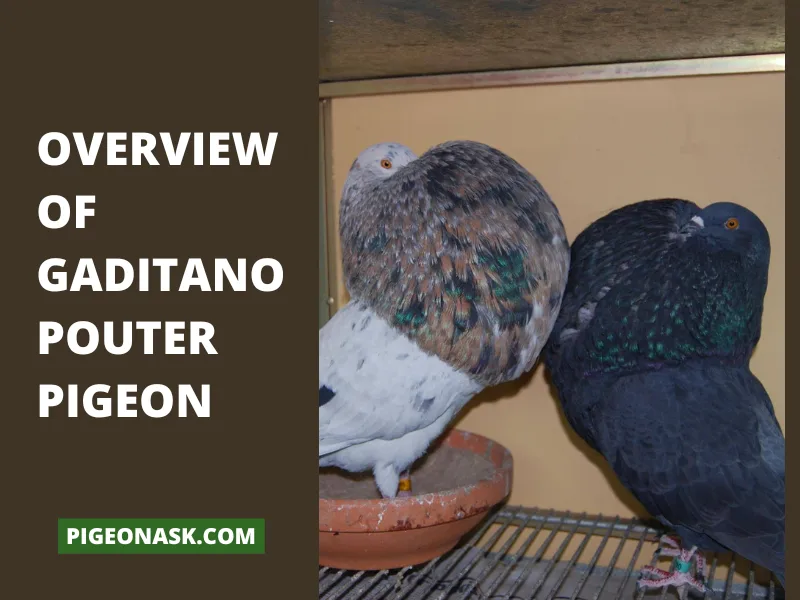
Pouter pigeons are also known as the “thieves” for their capability of stealing pigeons from other flocks. This rare quality of the pouters and croppers gave birth to a popular game called the “thieving.”
We know what you’re thinking. The title is rather anti-climactic for an intriguing sport like this, right?
Although a competent “thieving” player, the Gaditano pouters are used primarily for shows. They are in very demand nowadays, selling at a minimum of 300-400 bucks apiece.
Plus, they are easy to raise as they are gentle and possess no inherent fear of humans. However, they have breeding issues due to their large crops.
The “Thieving” Sport
The game, originating in Spain, became one of the most famous pigeon sports worldwide. Thieving is less popular in the US than it is in Europe, especially in England and Spain.
The sport is built around the pouter pigeons’ ability to seduce and take other pigeons home. Spanish Thief Pouters is the formal name of this group of expert thieving pouters.
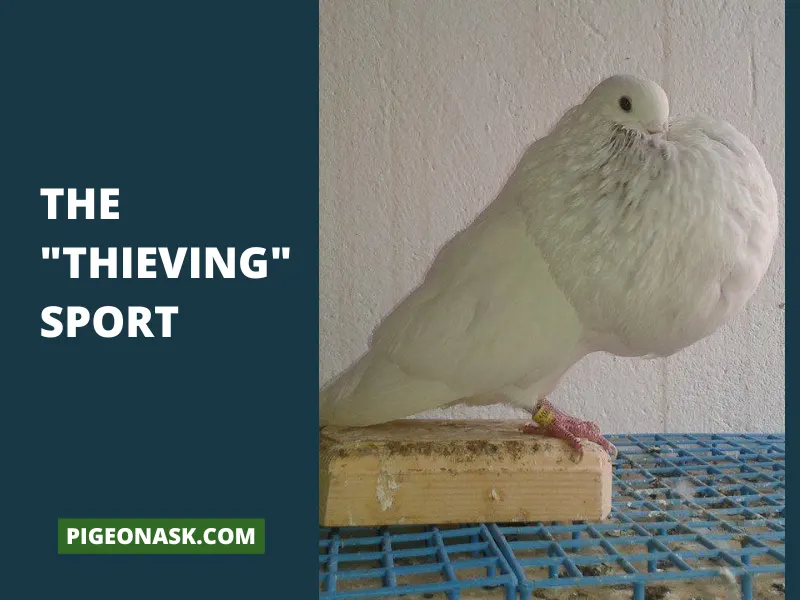
During the game, two or more pouters will woo each other and dance around aggressively while strutting. The one that takes the other pouter home is the winner.
Some fanciers specifically train their pouters to steal other fanciers’ pigeons and then sell them. This unethical means of livelihood has been becoming prevalent nowadays.
There is one game played only with Pica Pouters called “La Suelta,” popular in Valencia, where many roosters try to get close to a single hen using moves.
The participant roosters are painted with colors for distinction, and the hen has a white feather tied to her tail. And the winner is determined by a point system assigned to various kinds of moves.
History And Origins of Gaditano Pouter Pigeons
Historically, it is assumed that the Gaditano pouters originated and first grew popular in Spain.
Many sports and pigeon exhibitions revolving around the pouters started in that country. We have mentioned two of them above – “thieving” and ” La Suelta.”
As time went by, the popularity of these pigeons caught in the wind and spread like wildfire around the globe.
How Were They Bred And Developed?
It is assumed by the pigeon experts that Pouter pigeons were developed almost 400 years ago in Spain after years of selective breeding. The process has been carefully curated and conducted.
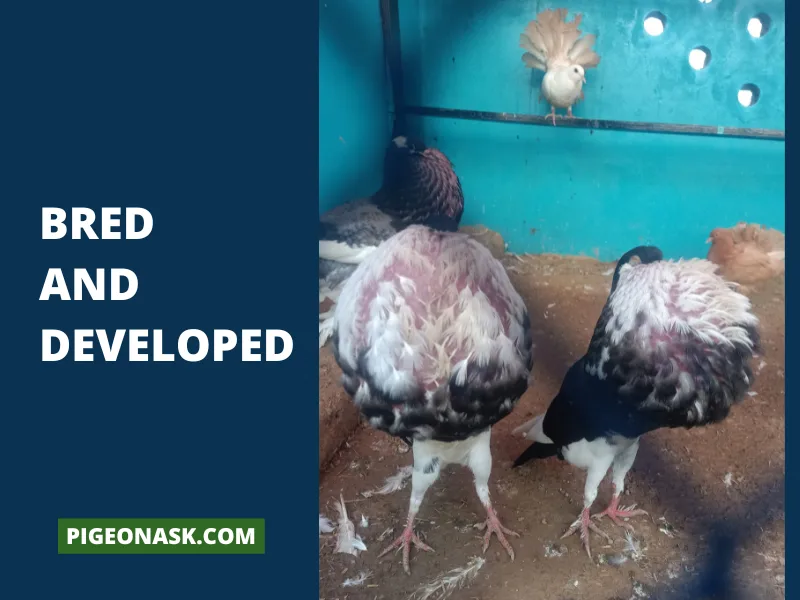
Wild doves are the ancestors of fancy pigeons. After noticing the exceptional capabilities of certain feral pigeons, humans started to tame them and breed them to achieve or boost specific traits and called them fancy pigeons.
Some fancy pigeons can fly high and return home, some roll, and some intrinsically sway and steal a female on the spot, our hero, the Gaditano Pouters, for example.
After successfully breeding this breed, fanciers started utilizing them accordingly, such as show birds, pets, and participants in sports. And in the process, people from other countries came to know this magnificent breed and liked them.
Thus, the Gaditano Pouters gradually spread worldwide.
Physical Characteristics And Features
Appearance
Gaditano Pouter pigeons are one of the largest pouters. They are tall and round-shaped. Plus, they have a balloon-like crop around the gullet that can swell with air. And their legs are a lighter shade of red with white stripes.
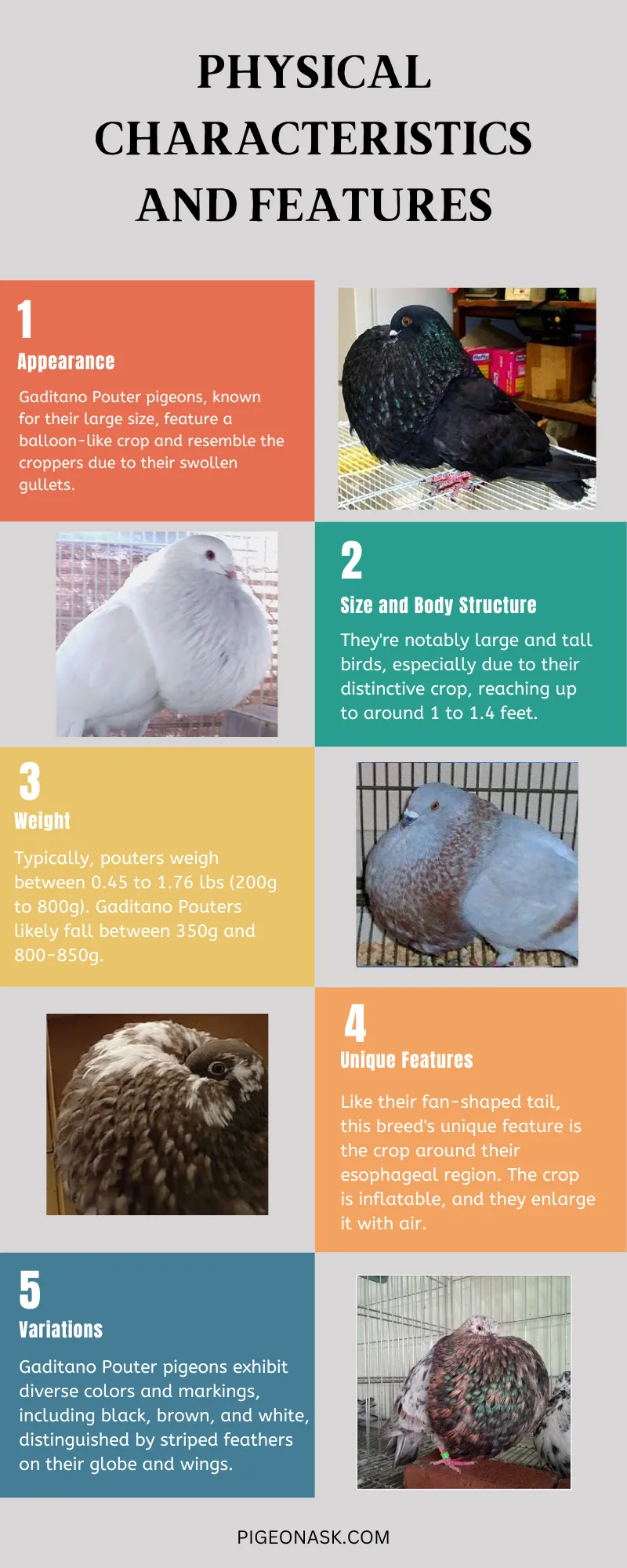
The croppers and pouters, although possessing different nicknames, are actually the same in characteristics, and both categories have a swollen gullet. Both get their names from having their infamous crops.
Size and Body Structure
They are very large and tall. Moreover, their crops add a significant heaviness to them. The average size of a pouter is around 1 ft to 1.4 ft. An adult pouter can get up to 16 inches in height.
Weight
The average weight of pouters can be between 0.45 lbs to 1.76 lbs (200g to 800g). Although the exact weight of this breed couldn’t be said, we can make a guess based on our information.
The average weight of Pigmy Pouters is around 350 grams, and as Gaditano Pouters are larger than Pigmy Pouters, they must weigh over 350 grams and less than 800-850 grams.
Unique Features
Like their fan-shaped tail, this breed’s unique feature is the crop around their esophageal region. The crop is inflatable, and they enlarge it with air.
Variations
Some common variations in colors and markings across different species. The Gaditano Pouter pigeons come in various colors and feather patterns, such as black, brown, and white.
One distinguishable factor of them is that the feathers around the globe and wings aren’t solid colored; instead, they are striped.
Distribution And Habitat of Gaditano Pouter Pigeon
Gaditano Pouter pigeons, originally hailing from Spain, have found their wings and settled in various corners of the globe. Their global presence is a testament to their popularity among pigeon enthusiasts.
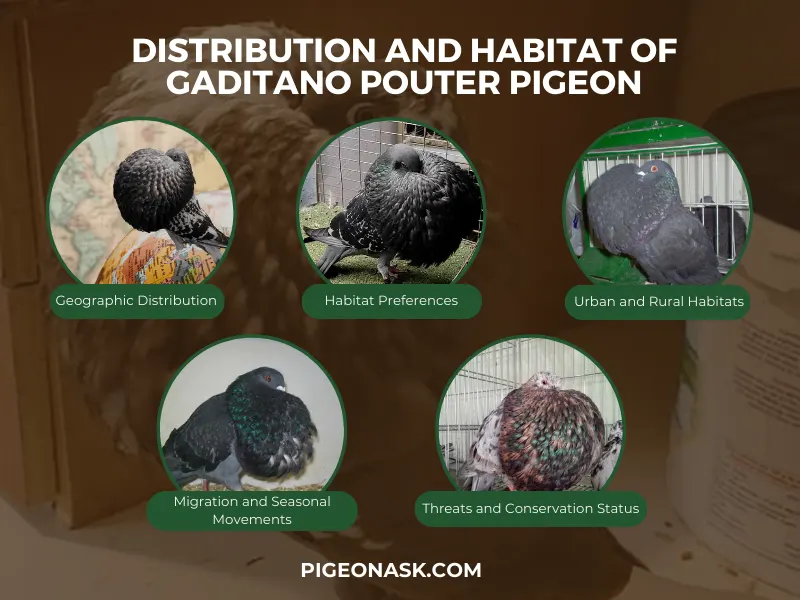
Let’s explore their geographic distribution, habitat preferences, urban and rural dwellings, migratory habits, and their current conservation status.
Geographic Distribution
Gaditano Pouter pigeons are available all over the world. Spain being the birthplace, this breed is an abundance in this nation.
Spanish fanciers are fond of this breed, and many of their pigeon competitions and shows are arranged around pouters in general, especially this breed.
Also, they can be found in large numbers and are popular in the Netherlands, the US, Bavaria, and England. Furthermore, this breed has also gained popularity in the Indian subcontinent.
Habitat Preferences
Gaditano Pouters, like other fancy pigeons, like their habitats to be dry, clean, free from insects, and safe from predators. Also, there should be water and food readily available.
Urban and Rural Habitats
Usually, Gaditano Pouter pigeons, being domesticated birds, live in specialized households built by their owners. However, you can also find feral them around rural and urban areas.
In urban areas, Gaditano Pouters make their nests in fire escapes, windows, under flyovers, bridges, roofs, etc.
And in rural areas, they build their nests in abandoned houses, barns, bushes, fallen tree logs, tree branches, etc.
Finally, they prefer to live near human settlements because they aren’t afraid of humans, and living near humans means abundant food and fresh water.
Migration and Seasonal Movements
Gaditano Pouter pigeons aren’t migratory birds. They prefer to stay where they build their nests, regardless of the change in seasons.
Although the feral ones might fly far every now and then, that’s only to look for food or a mate, and at the end of the day, they return home.
Threats and Conservation Status
This breed is prevalent around the world and isn’t under any threat as of now. Therefore, no conservatory strategies are currently being undertaken for them.
Behavior And Traits of Gaditano Pouter Pigeons
Gaditano Pouter pigeons, with their endearing personalities and unique traits, beckon us into the captivating world of pigeon fanciers.
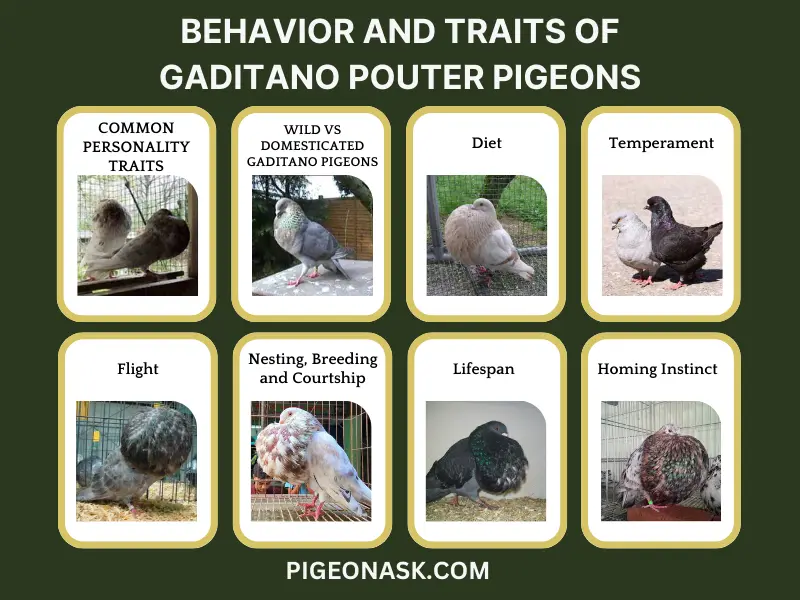
Let’s delve into their common personality traits, the differences between wild and domesticated pigeons, their dietary preferences, temperament, flying prowess, nesting and breeding rituals, lifespan, and homing instinct.
Common Personality Traits
Gaditano pouters are social and intelligent. They can remember people’s faces and can recognize their owners. This breed isn’t afraid of humans and can easily get tamed. Fanciers refer to them as dogs for their friendly nature.
Differences between Wild and Domesticated Pigeons
The wild Gaditano Pouter pigeons are generally aggressive as they aren’t used to humans. They can adapt well and survive on their own.
The domestic ones are gentle with humans and can’t survive in the wild as they rely heavily on their owners for food and water. Furthermore, they can’t fight off predators.
Diet
This breed generally isn’t picky regarding food. Their primary diet consists of seeds and grain-based. They intake vegetables, nuts, and fruits, and for protein, they devour insects. Owners can feed their pouters store-bought pigeon feeds.
Wild Gaditano Pouters will eat whatever they can manage – leftover food, vegetables, seeds, fruits, etc. Furthermore, they go out on hunts for insects and worms.
It is important to note that gluten-based foods must not be given to pigeons as they are unhealthy.
Temperament
Gaditano Pouter pigeons are infamous for their calm and gentle nature. They are energetic and easygoing. Old-timing fanciers suggest newcomers start with Gaditano Pouters or any pouter in general.
Flight
Croppers, in general, like to show off. During flight, they take off by loudly clapping their wings and gliding while keeping the wings in a V shape.
While flying, they will try to attract potential mates into joining them. They land slowly and spread their wings over their back to show size and colors.
Nesting, Breeding and Courtship
The Gaditano Pouters live under human care and don’t have to build their nests.
However, if they absolutely had to, they would construct a nest like any other fancy pigeon would – above the ground, in a dry and clean place, safe from predators, and built with twigs, leaves, straws, and pine needles.
Due to their large crop, Gaditano Pouters face difficulty breeding compared to other breeds of fancy pigeons. The breeding process is done in cages in a controlled environment.
Breeders handle the process and pair up the mates accordingly to achieve desired traits in squabs. This breed, during courtship, inflates its throat as much as it can and attempts a prolonged and gentle coo to impress the potential mate.
Lifespan
The lifespan of fancy pigeons depends on the environment, diseases, weather, availability of food, etc. Wild Gaditano Pouters typically live between 3 to 5 years; it can be higher in some instances.
And the domesticated obviously live longer than their wild counterparts as they get proper care, ranging from 7 to 10 years.
Homing Instinct
The pouters are renowned for the size of their crop and seducing instinct but not for their homing ability. Another breed is famous for its homing instinct called the Homers.
Breeding And Maintenance
This breed is a bit more challenging to breed and maintain than other fancy pigeons. Below, we will go over the raising, breeding, housing, and feeding requirements.

Information about Raising and Breeding
Raising and breeding Gaditano Pouters is not an easy task. You have to be attentive 24/7, and it can get tiring. Therefore, don’t get into raising fancy breeds if you can’t be committed to the job.
The first thing you have to be vigilant about is their resting place. From time to time, you need to clean the habitats to eliminate invasive insects, parasites, and microorganisms.
You have to be careful what you’re feeding them. It’s typically easy to feed pigeons; however, they require special foods and extra nutrients during the breeding season and sickness.
You must take them to vets for regular checkups and provide all the necessary vaccines to keep them safe from common and seasonal viral diseases. Fancy pigeons are prone to infections and can die easily. Beware!
And finally, people typically raise fancy pigeons to get an enhanced batch of squabs. So carefully pair Gaditano pouters up to get the desired feather colors, shape, size of crops, etc.
Some Tips and Considerations for Successful Breeding
- Carefully pair up the couple with beautiful squabs.
- Always pair up healthy birds.
- It’s a good idea to breed them in cages under close surveillance.
- Make a wide-open loft if it’s meant to be the breeding ground.
- Keep at least 3 pairs of birds to avoid fighting and chaos. Constant conflict may disrupt the breeding process.
Feeding and Housing Requirements
- During the breeding process, they must get extra.
- Safflower seeds and garlic are required to keep the feathers fluffy and shiny.
- Epsom salt, calcium-based feeds, rue tea, and crushed mortar can keep them healthy during the breeding season.
- You should avoid giving your pigeons chocolate and gluten-based foods.
Housing Requirements
- Build an expansive loft of at least 7 square feet and make sure it’s clean, secure, and gets plenty of sunlight.
- Clean their houses regularly to exterminate insects.
- It’s better to build a proper cage for successful breeding.
Conclusion
We have come to the end of our article. All we hope is that it was as educational and fulfilling for you guys as it was for us.
Now that you know that breeding and raising Gaditano Pouter pigeons is difficult and tiring, you should definitely give proper thought to the idea of raising them. This article should help you during the thinking process.
Gaditano Pouters require timely vaccine shots, controlled breeding, healthy foods, and freshwater to sustain properly. Therefore, do make sure to raise your pigeons sincerely if you end up buying some. That said, good luck.
